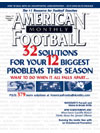AMERICAN FOOTBALL MONTHLY THE #1 RESOURCE FOR FOOTBALL COACHES
Article CategoriesAFM Magazine
|
Implementing the Saluki Zone Blitz Blitz PackageHow Southern Illinois Brings Pressure Out of its Odd Frontby: Mike Kuchar Senior Writer, American Football Monthly © More from this issue In our March issue this year, American Football Monthly presented an overview of the zone blitz scheme and its concepts. It’s a scheme that has been around for over thirty years originating with the innovative mind of Bud Carson, the notorious coordinator of the Pittsburgh Steelers “Steel Curtain” defense in the 1970’s. Though it has been tweaked into some more of the style we see today, the general concepts of the zone blitz remained constant. In its simplest form, the zone blitz scheme is generally a five-man pressure package with three deep and three underneath defenders playing coverage. While the three deep defenders play thirds of the field, the underneath defenders consist of two curl/flat defenders that react off the number two receiver and a middle hook dropper who plays off the number three receiver. As discuss....The full article can only be seen by subscribers. Subscribe today!
|
|
|||||||
| HOME |
MAGAZINE |
SUBSCRIBE | ONLINE COLUMNISTS | COACHING VIDEOS |
Copyright 2025, AmericanFootballMonthly.com
All Rights Reserved





